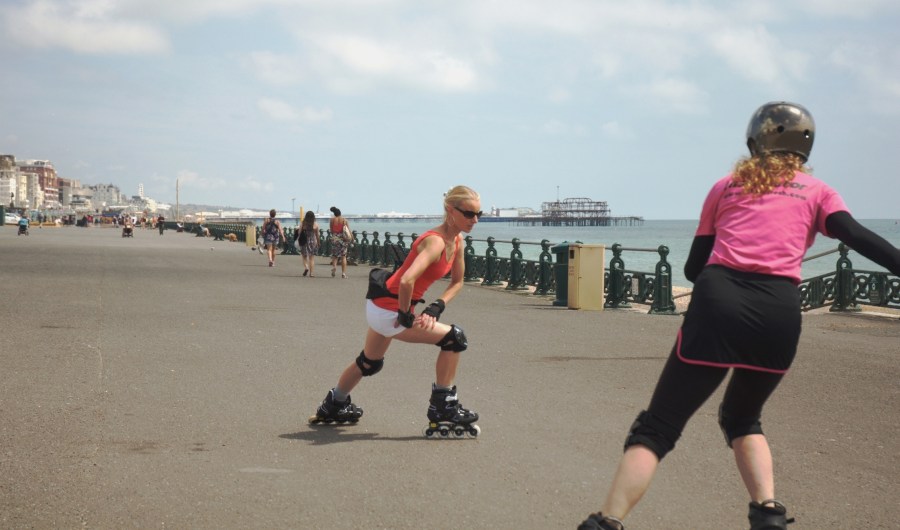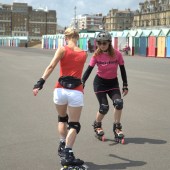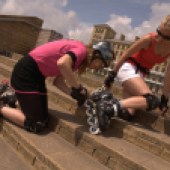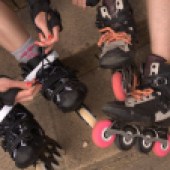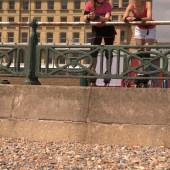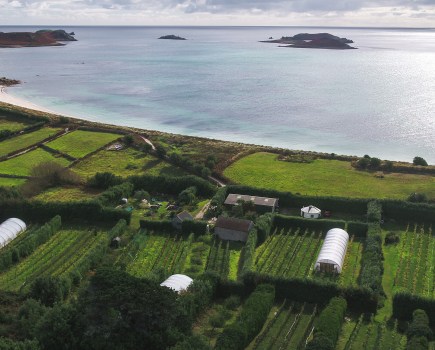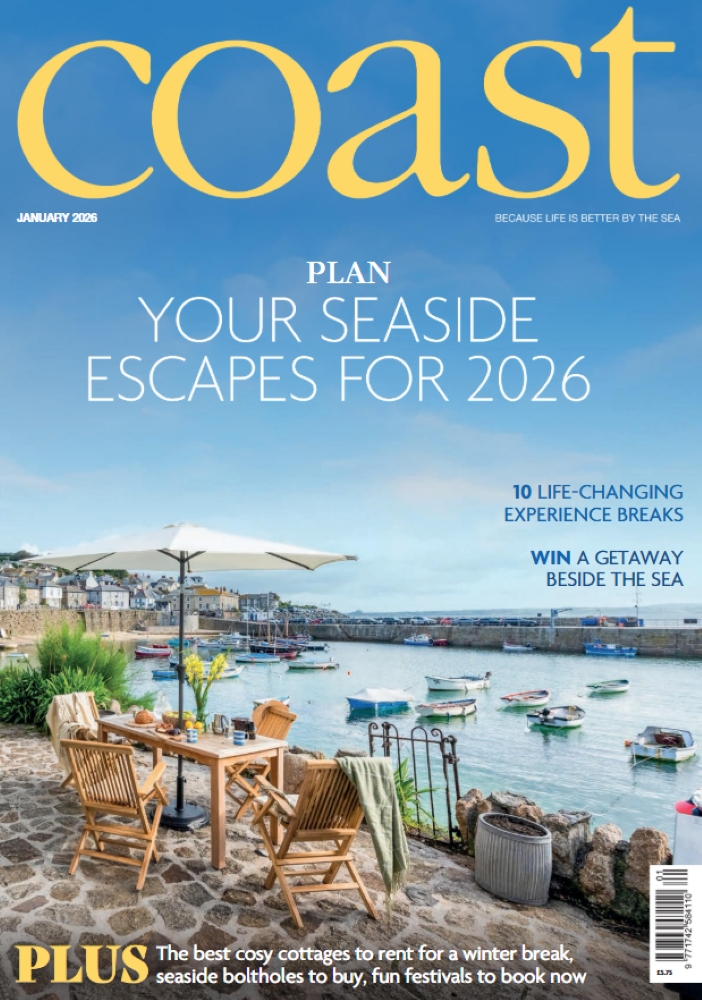Get your skates on! Rollerblading isn’t just for kids – it’s great for fitness and fun, too, as Hazel Sillver found out when she went for a spin…
Like many things from the 1980s, rollerblading has been enjoying a resurgence in popularity. And while some trends from that time (shell suits and ra-ra skirts, for instance) are best left there, it seems people are pleased that skating is back with a vengeance. Recently, many leisure centres have begun to host roller discos, and in cities such as London, hundreds of rollerbladers now gather for weekly street skates.
The reason for our love of rollerblading isn’t hard to fathom. Rolling around on four wheels is fun! Although it doesn’t feel like exercise, it is brilliant for flexibility, co-ordination and aerobic strength. ‘Skating is comparable to running and cycling in terms of calories burnt per hour,’ says top skating instructor Asha Kirkby, whose company Skatefresh runs private and group classes in London and Brighton. ‘It’s also great for anyone overweight who hasn’t exercised for a while, because they can start off gently.’
Rollerblading is also incredibly social. Rollerbladers are, by and large, a friendly bunch, who are happy to share their skills with newcomers. ‘It’s a brilliant family activity, too,’ says Asha. ‘I have several clients who learn as a family. Sometimes the adults are reluctant to begin with, but they soon get addicted.’
12PM BOOTS ON
Whenever the sun is shining where I live in Brighton, the rollerbladers come out to play. They whizz along the seafront and, upon the smooth tarmac of the skate areas, or ‘pads’, they weave in and out of cones and dance about, usually with a smile on their faces. The last time I was on roller skates was when I was about 12 years old. Back then, I used to tear along the family drive from the front lawn to the back, using the grass as a brake. Today, despite being 36, I fancied having another go… and learning to stop! And I’m not alone. Several other 30- and 40-somethings have gathered for the monthly Skatefresh beginners’ workshop on Brighton seafront.
12:15PM LESSONS IN FALLING OVER
When everyone has booted up, Asha, who is teaching us this afternoon, begins by showing us how to fall over correctly. ‘There are good and bad ways to go down,’ she says. ‘The worst is to stand too upright in your boots and fall backwards.’ Adjacent to the seafront is a large expanse of grass. Strapped into our obligatory knee and wrist guards, we all copy Asha in purposefully falling over in a safe manner. ‘Land on your knees first, then slide on to your wrist guards,’ she explains as she demonstrates. My body resists, but once I do it, it doesn’t hurt since the guards are solid bowls of cushioning and hard plastic.
12:30PM FEELING STABLE
On the safety of the grass, Asha shows us how to stand up – without toppling over – and then teaches us the ‘ready position’. This is the stable stance that should be returned to whenever we feel wobbly. ‘Your knees should be bent, pressed against the front of your boots,’ she says, demonstrating. ‘Keep your arms stretched out in front – this keeps you steady and ensures that you land comfortably if you fall.’ We all copy, at first making the mistake of sticking our bottoms out and not pressing into the front of our boots. When I eventually bend my knees sufficiently, the ready position feels very stable.
12:45PM READY TO ROLL
Then it was time to head out on to the tarmac. The skate pad at the Hove Lawns area of Brighton seafront is a smooth patch of the promenade, right next to the beach. We were lucky to be rollerblading on a warm day and the sun danced upon the waves, just metres away. We propel ourselves by making small, V-shaped steps and then rolling into our ready positions. We also learn a cruising stance called the ‘scissor’, which involves having one leg gliding slightly in front of the other. ‘The scissor is a stable stance to use when you have to skate over something bumpy, such as a drain cover,’ Asha tells us.
1PM LEARNING TO STOP
Next came the most important lesson – how to stop! Those who had heel brakes were taught to move into a scissor position and then lift the boot to engage the brake. Those without were shown a T-stop, which involves bending one leg and dragging the other boot horizontally behind. Both proved easy, everyone agreed, once we’d all obeyed the command to bend our knees! ‘I would advise all beginners to buy a pair of skates with a heel brake,’ says Asha. ‘Once you improve, you can take it off and use the T-stop and other stops.’
1:45PM GOING ROUND THE BEND
It’s time to learn how to turn. Asha elegantly demonstrates a parallel turn, serenely gliding around a corner with her arms outstretched. ‘The turn all happens in the upper body,’ she instructs. ‘Move your eyes, arms and shoulders in the direction you want to turn.’ A couple of people in the group pick the turn up straight away, whereas most of us end up heading towards the beach rather than around the corner! A little practice is needed…
2PM STAYING UPRIGHT
Everyone has done really well. Yes, we all look like beginners, kitted out in protective gear and moving with wobbly trepidation, but nobody has fallen over. Amazing! ‘Everyone assumes they’ll be falling all over the place as a beginner, but if you’ve been taught how to stand in a ready position and scissor, then you should stay upright,’ assures Asha.
Rolling around on the seafront is so much fun and I can tell it could get very addictive. Sign me up for the next workshop!
NEED TO KNOW
HOW TO GET STARTED
The first thing is to find a good skate instructor. Skatefresh offers lessons in London and Brighton. You can also purchase lesson video apps for Android and iPhones.
WHAT IT COSTS
A two-hour beginner or intermediate group lesson with Skatefresh in Brighton costs £20. Private hour-long lessons with Asha are £50. For more information, go to skatefresh.com/brighton
EQUIPMENT NEEDED
At the very least, knee and wrist guards; some people also wear elbow pads and a crash helmet. Beginners need boots with laces, a heel brake, two ankle straps and 80mm wheels. Good suppliers are LocoSkates locoskates.com and Club Blue Room clubblueroom.com Skates cost between £70 and £250. A set of knee, elbow and wrist guards costs £25.
HOW TO GET THERE
Brighton is an hour from London by train and up to two hours by car. The city’s Hove Lawns skate area is west of the main and west piers.
WHERE TO STAY
There is a wide choice of accommodation in Brighton, including the Grand Hotel.
ASK THE PRO
Asha Kirkby is the founder of Skatefresh and the UK director of ICP, the international body that trains and qualifies skate teachers.
‘I found my first pair of roller skates in a skip when I was 10. At that time, an ice rink was being built where I lived in Oxford and my plan was to get really good roller skating and then become an ice skater. But I fell in love with roller skating and decided to stick with it. I won the under-13s National Figure Roller Skating Championships, and I’ve been skating ever since. I qualified as an instructor in 1999 and started Skatefresh, teaching rollerblading in London. I’m also lucky to teach all over the world for ICP. In 2008, I came down to Brighton and started teaching here as well. Back then, there wasn’t much of a skate scene – now it’s really blossoming. I love teaching skaters anywhere, but it’s great doing it by the sea.’
Get your skates on! Rollerblading isn’t just for kids – it’s great for fitness and fun, too, as Hazel Sillver found out when she went for a spin…
Like many things from the 1980s, rollerblading has been enjoying a resurgence in popularity. And while some trends from that time (shell suits and ra-ra skirts, for instance) are best left there, it seems people are pleased that skating is back with a vengeance. Recently, many leisure centres have begun to host roller discos, and in cities such as London, hundreds of rollerbladers now gather for weekly street skates.
The reason for our love of rollerblading isn’t hard to fathom. Rolling around on four wheels is fun! Although it doesn’t feel like exercise, it is brilliant for flexibility, co-ordination and aerobic strength. ‘Skating is comparable to running and cycling in terms of calories burnt per hour,’ says top skating instructor Asha Kirkby, whose company Skatefresh runs private and group classes in London and Brighton. ‘It’s also great for anyone overweight who hasn’t exercised for a while, because they can start off gently.’
Rollerblading is also incredibly social. Rollerbladers are, by and large, a friendly bunch, who are happy to share their skills with newcomers. ‘It’s a brilliant family activity, too,’ says Asha. ‘I have several clients who learn as a family. Sometimes the adults are reluctant to begin with, but they soon get addicted.’
12PM BOOTS ON
Whenever the sun is shining where I live in Brighton, the rollerbladers come out to play. They whizz along the seafront and, upon the smooth tarmac of the skate areas, or ‘pads’, they weave in and out of cones and dance about, usually with a smile on their faces. The last time I was on roller skates was when I was about 12 years old. Back then, I used to tear along the family drive from the front lawn to the back, using the grass as a brake. Today, despite being 36, I fancied having another go… and learning to stop! And I’m not alone. Several other 30- and 40-somethings have gathered for the monthly Skatefresh beginners’ workshop on Brighton seafront.
12:15PM LESSONS IN FALLING OVER
When everyone has booted up, Asha, who is teaching us this afternoon, begins by showing us how to fall over correctly. ‘There are good and bad ways to go down,’ she says. ‘The worst is to stand too upright in your boots and fall backwards.’ Adjacent to the seafront is a large expanse of grass. Strapped into our obligatory knee and wrist guards, we all copy Asha in purposefully falling over in a safe manner. ‘Land on your knees first, then slide on to your wrist guards,’ she explains as she demonstrates. My body resists, but once I do it, it doesn’t hurt since the guards are solid bowls of cushioning and hard plastic.
12:30PM FEELING STABLE
On the safety of the grass, Asha shows us how to stand up – without toppling over – and then teaches us the ‘ready position’. This is the stable stance that should be returned to whenever we feel wobbly. ‘Your knees should be bent, pressed against the front of your boots,’ she says, demonstrating. ‘Keep your arms stretched out in front – this keeps you steady and ensures that you land comfortably if you fall.’ We all copy, at first making the mistake of sticking our bottoms out and not pressing into the front of our boots. When I eventually bend my knees sufficiently, the ready position feels very stable.
12:45PM READY TO ROLL
Then it was time to head out on to the tarmac. The skate pad at the Hove Lawns area of Brighton seafront is a smooth patch of the promenade, right next to the beach. We were lucky to be rollerblading on a warm day and the sun danced upon the waves, just metres away. We propel ourselves by making small, V-shaped steps and then rolling into our ready positions. We also learn a cruising stance called the ‘scissor’, which involves having one leg gliding slightly in front of the other. ‘The scissor is a stable stance to use when you have to skate over something bumpy, such as a drain cover,’ Asha tells us.
1PM LEARNING TO STOP
Next came the most important lesson – how to stop! Those who had heel brakes were taught to move into a scissor position and then lift the boot to engage the brake. Those without were shown a T-stop, which involves bending one leg and dragging the other boot horizontally behind. Both proved easy, everyone agreed, once we’d all obeyed the command to bend our knees! ‘I would advise all beginners to buy a pair of skates with a heel brake,’ says Asha. ‘Once you improve, you can take it off and use the T-stop and other stops.’
1:45PM GOING ROUND THE BEND
It’s time to learn how to turn. Asha elegantly demonstrates a parallel turn, serenely gliding around a corner with her arms outstretched. ‘The turn all happens in the upper body,’ she instructs. ‘Move your eyes, arms and shoulders in the direction you want to turn.’ A couple of people in the group pick the turn up straight away, whereas most of us end up heading towards the beach rather than around the corner! A little practice is needed…
2PM STAYING UPRIGHT
Everyone has done really well. Yes, we all look like beginners, kitted out in protective gear and moving with wobbly trepidation, but nobody has fallen over. Amazing! ‘Everyone assumes they’ll be falling all over the place as a beginner, but if you’ve been taught how to stand in a ready position and scissor, then you should stay upright,’ assures Asha.
Rolling around on the seafront is so much fun and I can tell it could get very addictive. Sign me up for the next workshop!
NEED TO KNOW
HOW TO GET STARTED
The first thing is to find a good skate instructor. Skatefresh offers lessons in London and Brighton. You can also purchase lesson video apps for Android and iPhones.
WHAT IT COSTS
A two-hour beginner or intermediate group lesson with Skatefresh in Brighton costs £20. Private hour-long lessons with Asha are £50. For more information, go to skatefresh.com/brighton
EQUIPMENT NEEDED
At the very least, knee and wrist guards; some people also wear elbow pads and a crash helmet. Beginners need boots with laces, a heel brake, two ankle straps and 80mm wheels. Good suppliers are LocoSkates locoskates.com and Club Blue Room clubblueroom.com Skates cost between £70 and £250. A set of knee, elbow and wrist guards costs £25.
HOW TO GET THERE
Brighton is an hour from London by train and up to two hours by car. The city’s Hove Lawns skate area is west of the main and west piers.
WHERE TO STAY
There is a wide choice of accommodation in Brighton, including the Grand Hotel.
ASK THE PRO
Asha Kirkby is the founder of Skatefresh and the UK director of ICP, the international body that trains and qualifies skate teachers.
‘I found my first pair of roller skates in a skip when I was 10. At that time, an ice rink was being built where I lived in Oxford and my plan was to get really good roller skating and then become an ice skater. But I fell in love with roller skating and decided to stick with it. I won the under-13s National Figure Roller Skating Championships, and I’ve been skating ever since. I qualified as an instructor in 1999 and started Skatefresh, teaching rollerblading in London. I’m also lucky to teach all over the world for ICP. In 2008, I came down to Brighton and started teaching here as well. Back then, there wasn’t much of a skate scene – now it’s really blossoming. I love teaching skaters anywhere, but it’s great doing it by the sea.’

